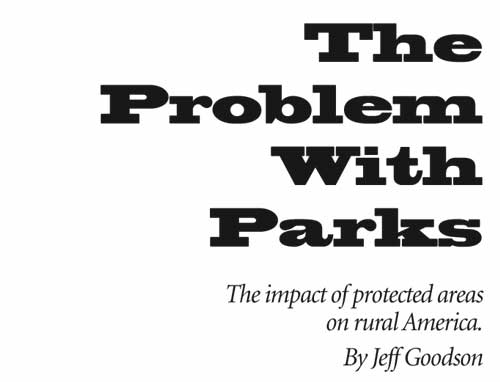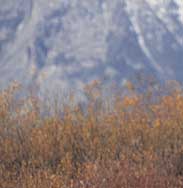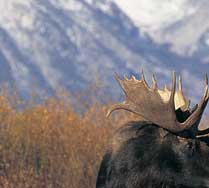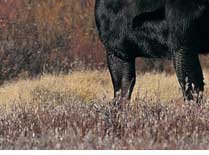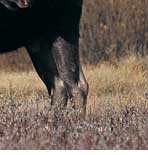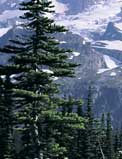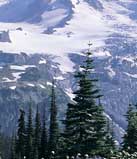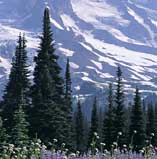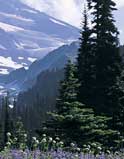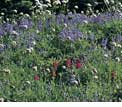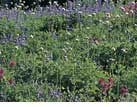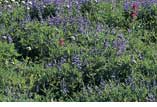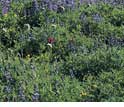|
|
|
| Subscriptions click here for 20% off! | E-Mail: info@rangemagazine.com |
|
Until a few years ago, you had a better chance of getting hit by a meteorite than of hearing anything negative about protected areas—the parks, forests, refuges and wilderness areas scattered across the American landscape. Times change, though, and the park that was once seen as a friendly vacation spot is now more often viewed by rural Americans as a threat to hearth and home. This change is due mainly to the impact of environmentalism on protected area policies. Through litigation and legislation, environmentalists have dramatically increased the number of protected areas in America, the acreage protected, put restrictions on multiple use, and restrictions on private property located anywhere near the parks. In the process, they have converted what was once a small and relatively benign system of protected areas into a large network of increasingly linked sites that can threaten property ownership, restrict property use, degrade property resources, increase property management and development costs, and reduce property value. The Protected Areas There are about two dozen major global, federal and state protected area programs in America. Each has its own legislative, regulatory and policy framework, and each represents a unique threat to rural communities. America hosts three major kinds of global protected areas—Ramsar Wetlands, World Biosphere Reserves and World Heritage Sites. These include over 80 separate sites, covering 50 million acres. Most are federally managed. Because they were established through formal international agreement, and because environmentalists routinely use this fact to bring international pressure to bear on domestic land-use policies affecting the sites, major sovereignty issues have been raised in conjunction with these programs. The federal government owns outright about 29 percent of all land in America. Over half of this—more than one in every seven acres—is designated as a federal protected area. Over 3,000 federal protected areas are designated in just seven major categories (see box). National parks are managed by the National Park Service, national forests by the U.S. Forest Service, and wildlife refuges by the U.S. Fish & Wildlife Service. Wilderness areas, landmarks, wild and scenic rivers and national trails mostly occur within these federal protected areas, but they can also occur on private property. In addition to the federally managed land, thousands of areas are protected by states, counties, municipalities and river authorities covering about nine percent of the country. Another 6.2 million acres are controlled by the 1,200 environmental land trusts currently operating in America—most of it by The Nature Conservancy, The Trust for Public Land and The Conservation Fund. Land at Risk Protected areas affect every corner of the American landscape. Adjacent and nearby land is at greatest risk of impact, but property located at great distances from a park can also be affected. Land located between two or more
protected areas, for example, is at special risk of targeting for acquisition. That risk is compounded when property is located along a stream connecting two parks, or along a rail line that is a candidate for conversion to a public use trail through the Rails-to-Trails program. Upstream property is also at special risk. Environmentalists see any land management practices upstream of protected areas as fair game, especially activities potentially affecting water quality. Animal feeding operations and livestock use of the riparian zone are a special focus of environmentalists, of land management agencies that take a watershed-based approach to property control, and of water quality regulatory agencies. Just operating within sight of a park can also be a risk. Almost any activity in the “viewshed” of a wild and scenic river, for example, can be refused a federal permit, delayed by advocacy group harassment, or prohibited through litigation. Major protected areas with viewshed impacts include national scenic byways, national trails, national heritage areas and national historic landmarks. Because the areal extent of the impact includes hundreds and sometimes thousands of square miles, viewshed programs are among the most damaging of all environmental programs to rural Americans.
The Impacts: Property Targeting Some protected area programs, like the Wild and Scenic Rivers and National Trails programs, authorize condemnation of private property. More common is simple targeting of land for acquisition. On top of owning 29 percent of the country, federal land management agencies plan to acquire another 17,000 square miles of private land in the future to establish new parks, expand existing areas and buy out inholders. Land most at risk of targeting includes inholdings, adjacent and nearby properties, and land located along “linkage lines” between existing protected areas. Other high-risk properties include those with any kind of surface water, old or climax vegetation, rare biological habitats, unusual geological formations, scenic vistas or historic sites. Endangered Species By both law and policy, most federal lands are managed for the protection, reproduction and spread of endangered species. The National Wildlife Refuge system includes habitat for some 249 listed species, and 56 refuges were acquired specifically to protect those organisms. Any land management policy that favors endangered species is of special concern to nearby landowners. The spread of endangered species from parks to private property usually means the coercive imposition of federal property controls, which can affect virtually all productive use of the land—from traditional farming, ranching and timber operations to suburban home construction. Property value can decline by over 90 percent in such cases, and the number of willing buyers can evaporate. Even when total use of the property is not prohibited, property management and development costs can skyrocket. Unless vegetation is carefully managed, property located near a park is at significantly greater risk of impact from contamination by endangered species than property located further away. Rural communities that rely on multiple use of the public lands have a related problem—force-listing of species through litigation to restrict historic water and grazing rights. The newest crop of candidate species for federal listing includes several that environmentalists say they hope “will dramatically affect public lands livestock grazing.” These include the mountain plover, mountain quail, yellow-billed cuckoo and sage grouse (known as the “spotted owl of the sagebrush sea”). Pests & Predators The harboring of predators in nearby parks has been an issue on western rangelands for 100 years, and it is of increasing concern as predator reintroduction increases and lethal control methods are sharply curtailed. Ranchers are also increasingly concerned that livestock diseases like brucellosis will spread from infected bison to disease-free stock. Although this particular issue has historically focused on the bison in Yellowstone National Park, the concern may spread as environmentalists promote the reintroduction of bison into other parks surrounded by cattle operations. Wilderness designation also increases the threat of pest outbreaks on nearby property, especially where “leave it alone” management policies and dense, overmature forests combine to produce destructive pest eruptions. In a 1983 outbreak of southern pine beetle in Texas, for example, environmental litigation and Forest Service wilderness policies caused severe economic losses when the outbreak spread to nearby private lands. Fire Land is also at much greater risk of fire damage when it is adjacent to a federal protected area. Over 10,000 fires a year typically occur on land protected by the Forest Service alone, and nearly half a million acres burn annually. Tens of thousands of fires also start on land controlled by the Bureau of Land Management, National Park Service and U.S. Fish & Wildlife Service, and homes can be destroyed. The threat of fire damage has increased in the last 30 years because of ecosystem management policies that emphasize a “let it burn” approach to wildfire control. While the number of wildfires declined from 1970-1990, the number of acres burned during that time nearly doubled. Natural Resource Damage One of the most ironic impacts of protected area management is the ecological damage it causes. Some public rangelands have been overgrazed by wild horses and burros, for example, and long-term mismanagement of
Yellowstone National Park has led to severe overgrazing by elk and bison. This can damage the value of water as well as grazing rights through increased soil erosion, bad water quality and hydrological impacts. Off-site private land resources, such as downstream trout fisheries, can also be affected. Endangered species management policies can also hurt natural resources. The many parks that protect golden-cheeked warbler habitat in Texas are a good example. Warbler habitat includes dense cedar thickets that shade out grass, poison the soil, wipe out native plant communities, ruin wildlife habitat and reduce biological diversity. Cedar is especially damaging to rivers and aquifers, intercepting 80 percent of the rain that falls on it and sucking up massive volumes of ground water (see Range, Spring 2002). Harassment and Litigation There is no greater focus for advocacy group harassment and litigation than America’s parks and protected areas. Major groups include the Wilderness Society, National Parks and Conservation Association and National Wildlife Refuge Association, but hundreds of local groups focus on influencing how specific parks are managed. Some pride themselves in suing over park management policies, and ballyhoo their lawsuits in fund-raising literature. Advocacy group harassment and litigation can have a big impact on land owners and users as environmentalists try to control property use in the upper watersheds of the protected areas, in vast buffer zones around them, and anywhere else that can be construed as necessary for site protection. Environmental Espionage Few environmental issues infuriate landowners more than “environmental espionage”—the covert collection of environmental data on private property without the landowner’s knowledge or consent. In many cases, the information is used to target property for acquisition. Under the National Natural Landmarks program, for example, 363 Texas properties were studied for inclusion in the landmark system by the National Park Service. Most were private and many were evaluated covertly. Covert data is often used to fight property development in buffer zones around protected areas. Landowners in close proximity to and upstream of protected areas are at especially high risk. Property Value Parks can be an asset to nearby landowners in suburban areas, increasing property value because of the privacy they provide and the assurance they afford against some kinds of property devaluing development. In rural areas, conversely, parks can lower property value by increasing property management and development costs, or by reducing the “highest and best use” of the property at appraisal. Historic parks are notorious for this but any protected area that leads to property use or management restrictions in buffer zones around a park can threaten value. Tax Revenues When productive land is converted to a park, the financial flow of property taxes generated from the use of that land dries up. And because property taxes are usually a zero-sum game, loss of property taxes on some land means higher property taxes for all other landowners in the county. The loss of tax revenue has long been an issue, and both the state and federal government in some cases make annual PILT payments (Payments In Lieu of Taxes) to host counties. Payments often do not cover the revenue shortfall, however, and tax loss from the sale of land to environmental land trusts or through the establishment of environmental easements is almost never recovered or reimbursed. Restriction of Public Works Projects An important indirect impact of protected areas is their use as a reason to kill or modify public works projects that benefit rural Americans. In some cases this impact is built into the underlying law. A key provision of the Wild and Scenic Rivers Act, for example, is that “federal agencies cannot assist by loan, grant, license, or otherwise in the construction of any water resources project that would have a direct and adverse effect on river values.” Increasingly, however, the impact occurs as a byproduct of protected area policies. Last year’s train wreck at the Klamath Basin is a good example (Range, Fall 2001) where endangered species harbored by two national wildlife refuges were used to abrogate long-standing water rights agreements. Epilogue In a scant quarter century, environmentalists have converted a small and relatively benign system of protected areas into a spaghetti bowl of government land-control units that can threaten property ownership, restrict property use, degrade property resources, increase property management and development costs, and reduce property value. Today parks play an important role in the rape of rural America. For private property owners, and for those who make a living on the public lands, protected area policies have become as much a threat as a promise. Jeff Goodson, a regular contributor to Range, is president of JW Goodson Associates, Inc., a property consulting company. He can be reached at 1-800-998-8481 or by e-mail at <jwgoodson@aol.com>. |
|||||||||||||||||||||||||||||||||||||||||||||||||||||||||
|
Summer 2002 Contents To Subscribe: Please click here or call 1-800-RANGE-4-U for a special web price Copyright © 1998-2005 RANGE magazine For problems or questions regarding this site, please contact Dolphin Enterprises. last page update: 04.03.05 |
|||

